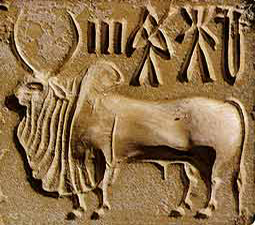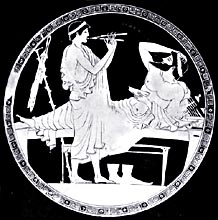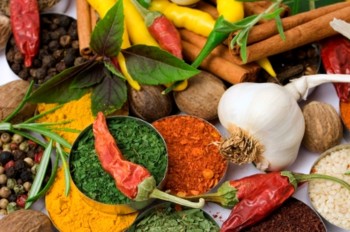By Dave DeWitt
Recipes:Canned Coconut Milk |
“Curry is India’s greatest contribution to mankind,” claims Norman Douglas, a British novelist and travel writer. I assume that Douglas’s tongue was firmly planted in his cheek when he wrote this assessment, but his comment hints at a wide range of opinion about the subject, from those people who believe, like cookbook author Manju Shivraj Singh, that “the tongue becomes a slave to the flavor of curry–it is an addiction,” to critics who view curry as an insipid yellow powder that is turned into a floury, yellow cream sauce.
The never-ending arguments about curry begin with its origin.
Curry Controversies
One of the most intriguing theories about the ancestry of curry was advanced by Captain Basil Hall, a traveler in India, Ceylon, and Borneo. “It will surprise most people–old Indians inclusive,” he wrote in 1930, “to learn that the dish we call curry is not of India, nor, indeed, of Asiatic origin at all. There is reason to believe that curries were first introduced into India by the Portuguese.” Hall reasoned that since Portuguese traders had introduced chile peppers into India, and since chiles are a main ingredient in curries, ergo, the traders must have introduced curries as well.

Harrappan Bull Seal
Hall was dead wrong, of course. Curry-like spice mixtures date back to at least 4,000 B.C. In excavations of the ancient cities of Harpatta and Mohenjo-Daro in the Indus Valley in what is now Pakistan, grinding stones were found that contained traces of mustard seed, cumin, saffron, fennel, and tamarind. Since all of these spices appear in curries, it is not unreasonable to assume that the ancient Indus Valley people were cooking with curry spices 6,000 years ago–although no recipes survive.
“Many people consider them (inhabitants of Mohenjo-Daro, called the Harappan Culture) the world’s first gourmets and creative cooks,” wrote Willam Laas in Cuisines of the Western World. “Their achievements may be measured by the fact that their seasonings were adopted by all who came after them.”

Athenian Vase Painting Portraying “The Indian Fashion” Feast
One of the first written mentions of curry-style cookery is attributed to Athenaeus, a Greek miscellanist who lived about A.D. 200. In his Deiponosophistai, “The Gastronomers,” a fascinating survey of classical food and dining habits, he quotes Megasthenes, the third century B.C. author of Indica: “Among the Indians at a banquet a table is set before each individual…and on the table is placed a golden dish, in which they first throw boiled rice…and then they add many sorts of meat dressed after the Indian fashion.”
“The Indian fashion,” as mentioned by Athenaeus, has sparked most of the curry controversies because some writers and cooks believe that the “Indian fashion” of curry has been stolen and ruined by the rest of the world, especially by the English. Other writers think that notion is nonsense, and they believe that cookery continues to evolve as the world shrinks. In fact, there are multitudinous definitions and beliefs about curry, and rarely do two writers agree on precisely what curry is.
“Curry in its twentieth century manifestation–a meat or occasionally vegetable stew flavoured with commercial curry powder–is essentially a British dish,” wrote John Ayto, author of The Glutton’s Glossary. He was taking the oversimplified stance that all curries are made with commercial curry powder, which simply is not true, despite an abundance of commercial curry powders and other products.
M.F.K. Fisher, the famous gastronome, disagreed with the curry powder-stew concept, believing the preparation of curries to be a high art: “Books about curries, for instance,” she wrote, “are published continually, with the success of a well-ticking clock. Special restaurants all over the world serve nothing but curries. Spice merchants grow rich on making their regional and private blends of curry powder. In other words, reputations can and do depend upon the authenticity of the recipe first and then of the powder that goes with the sauce, the skill with which the sauce is made, and in many cases the atmosphere in which the whole is served.”
Curry Myths
During the research for this series, I have uncovered four primary myths about curry that need to be refuted.
Curry Myth Number 1: Curry is a spice. This fiction continues to spread despite numerous books on spices and Indian cooking. Curry leaf (Murraya koenigii) is a single herb used in some curries, but in reality, there are dozens and dozens of herbs, spices, fruits, rhizomes, bulbs, pulses, nuts, and other ingredients that are combined to make curries. Here is an example of some of the myriad of ingredients used to make curries:

Some of the Many Curry Ingredients
Curry Myth Number 2: All curries are the same. Nothing could be further from the truth. “Contrary to popular belief,” notes Sri Lankan food importer Anura Saparamadu, “there are about as many types of curries as there are spices.” And given the total number of curry ingredients, the combinations and permutations of those ingredients provide a nearly infinite variety of flavors in curries. “Even the best Indian cooks will argue endlessly over the inclusion and exclusion of particular spices and herbs,” adds food writer Santha Rama Rau.
Curry Myth Number 3: Authentic curries cannot be made outside their countries of origin. Purists often say that to enjoy genuine curries, one must travel to all the regions covered in this book. Virtually every exotic curry ingredient (and every one in this series) is available in the United States in Asian markets or by mail order. Besides, across the Indian subcontinent, as well as in other curry countries, cooks boldly experiment, and it is possible to get five or six variations for the same recipe. So, cooks should just use these recipes as a rough guide, and feel free to experiment. In all cases, even with a few substitutions, the recipes will be authentic–meaning, as in the dictionary, reliable and genuine.
Curry Myth Number 4: No self-respecting Indian cook would ever use commercial curry powder. Virtually every writer on the subject of curry or Indian food falls for this falsehood, or some variation on the theme, as if to say that all commercial curry products are bogus. Expatriate Indians in other parts of the world, such as the United States and Canada, commonly use commercial powders, pastes, oils, and sauces. And in India, as Tom Stobart, author of The Cook’s Encyclopedia, observes: “Books commonly say that Indians do not use curry powder. This may have been true in the days when even the servants had servants and the masala of fresh ginger, garlic, onion, coconut, green chile, and spices was ground on the stone freshly for each dish. But today [1980], a First World cost of servants has caught up with Third World households, and ready-ground spice mixtures are no longer beyond the pale.”
This is not to say that curry cooks now use commercial preparations to the exclusion of homemade curries, but rather that they have now the option because of the vast number of commercial products on the market.
Indian food expert Julie Sahni takes a liberal view of the most basic ingredients required to make a curry: “For a spice blend to be called a curry powder, the mixture must contain three core spices: coriander, turmeric, and pepper.” Others will disagree, asking “where’s the cumin?” or chile or any other of their favorite spices. The point here is that many spice blends not originally defined as curry powders, such as those from North Africa and the Middle East, can easily fit into the broad category of curries.
Basic Recipes
Following are recipes for two essential curry recipe ingredients and a substitution that are called for many times in this series. Also included is a brief discussion of canned coconut milk.
Ghee

Ghee is clarified butter; that is, butter with the milk solids and moisture removed. It imparts a unique flavor to curries and has a higher smoking point than many vegetable oils, such as olive. When cooled, ghee will keep for about a year without turning rancid. Although some sources say it does not need to be refrigerated, just to be safe we recommend refrigeration. There are a surprising number of ways to make ghee, including boiling the butter in water, but I believe this recipe is the easiest. Some people add a curry leaf or bay leaf when cooking for added flavor. Note: never use salted butter for ghee.
2 pounds unsalted butter
Melt the butter in a heavy saucepan, then increase the heat slightly to just below the simmering point of the butter. Cook for 45 minutes, stirring any foam that rises back into the butter.
Remove the pan from the heat and allow the butter to cool to lukewarm. Carefully pour off the top layer of clarified butter, allowing the solids on the bottom to remain in the pan. Strain the butter through muslin cloth or through a sieve lined with paper towels.
Store in the refrigerator in a wide-mouthed jar with a screw lid.
Yield: 1 3/4 pounds (about 3 cups).
Coconut Milk and Cream

Both of these liquids are extracts from coconut and it is important to differentiate them from the highly sweetened, canned coconut cream (or syrup) that is used to make drinks called piña coladas. The canned cream is not a substitute and should not be used in any recipe in this series. Coconut milk is used extensively in curries and it is best when made from freshly grated coconut meat. But if that is not available, use dessicated, unsweetened coconut flakes and substitute cow’s milk for the water. Coconut milk powder is now available in some specialty markets, which mixes well with water to make coconut milk. Coconuts are widely available in Asian markets and large supermarkets across the U.S. and other countries. Look for a coconut without cracks or any sign of mold. The fresher the coconut, the more liquid it has. To break a coconut open, heat the oven to 350 degrees. Puncture a hole through one of the “eyes” and drain the liquid. This coconut water makes an excellent drink and can be consumed straight or mixed with rum or scotch. Place the coconut in the oven for 20 minutes, then remove it and allow it to cool. Break it open with a hammer, and the meat should fall away from the shell. If some meat still clings to the shell, carve it out using a small knife. Use a vegetable peeler to remove the thin brown skin from the meat, and then grate the meat with a metal grater, or carefully chop it in a food processor using the “pulse” mode.
4 cups grated coconut
2 1/4 cups boiling water or hot milk
In a bowl, cover the grated coconut with with the boiling water (or milk for a thicker coconut “cream”) and let it steep for 15 minutes. Using a strainer, drain the coconut and reserve the “milk.” The coconut meat may be squeezed through muslin cloth or a double layer of cheesecloth to collect the rest of the “milk.”
Store the “milk” in the refrigerator (it has about the same shelf life as whole milk), and the “cream” will rise to the top.
Variation: For a thicker milk, approaching cream, instead of steeping the grated coconut in hot water, puree it in a blender with the water and then strain it through cloth.
Yield: 2 cups
Coconut Milk Substitutes

One cup of coconut milk contains–depending on its thickness– about forty-five to sixty grams of fat–quite a bit in today’s world of low-fat diets. Fortunately, a commercial low-fat coconut milk is now available that reduces the fat level to about twelve and a half grams. To lower the level even further, I suggest using a coconut flavoring. Several companies manufacture coconut flavoring, or extract, which concentrates the flavor while removing nearly all of the fat. There are several brands of coconut extract on the market, both natural and imitation. They are available through Internet retailers and also through gourmet shops. By combining such extracts with whole milk, the amount of fat is decreased to eight grams; when combined with low-fat milk, that figure is further reduced to five grams. These substitutes may not be perfect, but they are a lot healthier. Since the consistency of coconut-flavored milk is thinner than that of canned coconut milk, cooks may need to add more of the substitute to a recipe and cook it a bit longer to achieve good results. Yogurt can also be combined with coconut extract; the consistency will be thicker, the taste will be different and interesting, but the fat count will be even lower, to about three grams.
1 cup milk (whole or low fat)
1/2 teaspoon coconut extract
Combine the ingredients in a bowl and stir.
Yield: 1 cup
A Note on Canned Coconut Milk
Canned coconut milk is commonly available, but cooks should check the label to make certain that sugar has not been added. The healthiest canned coconut milks are the low-fat varieties, but they are not the tastiest–some have an off-flavor. The best thing to do is buy several cans and taste them yourself to find out which one has the best coconut flavor. Asian and Latin markets usually have the best selection. For the best curries, I recommend using regular coconut milk, despite the high amount of fat. This fat is easily metabolized by the body, and contrary to popular belief, it does not transform into cholesterol to clog up your arteries.





